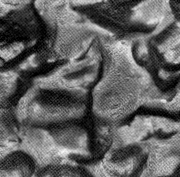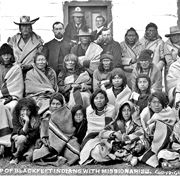Official Name:
Iron Creek takes its name from a river near the place it was discovered. Battle River, Saskatchewan, and Victoria are synonyms for Iron Creek. In Cree, the stone is called
pi-wa-pisk-oo ("meteorite found on the neighbouring hill") or papamihaw asiniy ("flying rock").
Location:
On a hilltop near Iron Creek, a tributary of Battle River, in southern Alberta, Canada. The meteorite was found very close to the present-day boundary between Alberta and Saskatchewan.
Fall or Find:
Iron Creek is a find.
Date:
This meteorite became widely known in the 1860s, when it was transported to the Methodist mission at Fort Victoria The Native Americans in the area around Iron Creek had known about this mass of iron for a long time, and they had talked about it to many explorers and missionaries.
Mass Recovered:
Iron Creek has a mass of 145.25 kilograms. The mass historically reported was 175 kilograms, but recent weighings contradict this data. This meteorite gets the bronze medal among the heaviest Canadian specimens.
Number of Fragments:
A single fragment was recovered. It has the shape of a flattened cone. The fragment measures 22 centimetres high and 56 centimetres in length.

Enlargement
The Iron Creek meteorite has deep regmaglypts. The profile of a nose can easily be seen along the right edge of the meteorite. |
|
Circumstances:
The meteoroid's fall was not observed. However, evidence shows that the Iron Creek meteoroid was oriented as it passed through Earth's atmosphere. The convex bottom of the cone-shaped meteorite was directed downward, something like an Apollo command module returning to Earth. This resulted in the fusion crust being thicker at the top of the cone where vaporized matter accumulated. In addition, the "thumbprints" (regmaglypts) caused by ablation are deeper on the meteorite's underside.
Iron Creek is easy to distinguish from terrestrial rocks. This is why people were able to recognize it so long ago. It is marked with deep regmaglypts, and its contour is jagged and polished from its passage through the atmosphere.
History:
This iron meteorite was revered by generations of Native Americans. Part of the meteorite resembles the profile of a human face. The Native Americans saw their god Manitou in this face, and they believed that the object had fallen from the sky. No group could pass through the area without paying a visit to the divine iron mass and making offerings. When Iron Creek was taken to a Methodist mission, the Native Americans protested strongly. The missionaries had ordered the large meteorite to be moved because they considered it an obstacle to the religious conversion of the Native Americans.
The meteorite was kept in the mission yard at Fort Victoria for about15 years. Today, it is held in the Provincial Museum of Alberta, in Edmonton.

Enlargement
A group of Blackfoot natives meeting missionaries at the end of the 19th century. |
|
Type:
Iron meteorite
Class:
Medium octahedrite (1.1 millimetre bandwidths)
Group:
IIIAB
Composition:
The Iron Creek meteorite is composed of over 91% iron, about 8% nickel, and traces of cobalt, gallium, and germanium. The meteorite has been altered to a depth of 3 millimetres beneath its fusion crust.
Comments:
Iron Creek's shape makes it very unusual. The profile of a human face is very easy to see when the meteorite is held at the correct angle.
Part of the Planétarium's collection:
No